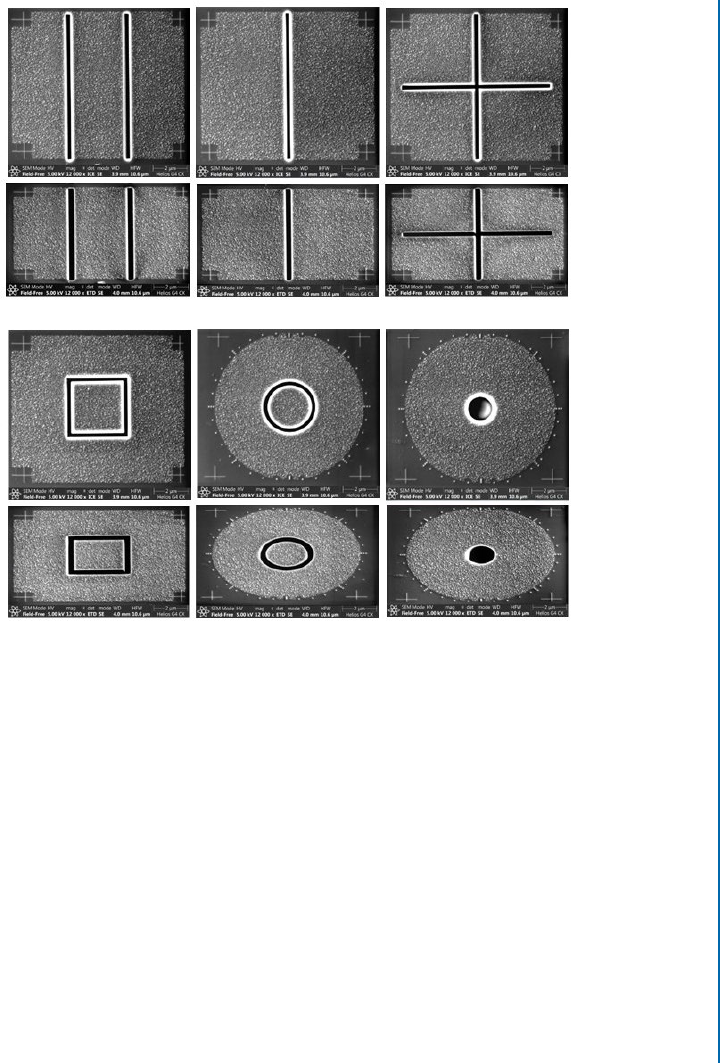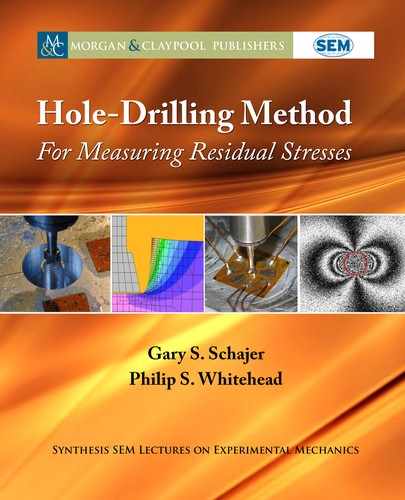
38 2. RELAXATION TYPE RESIDUAL STRESS MEASUREMENT METHODS
Partial
Sectioning
Complete
Sectioning
Slicing
Figure 2.11: Sectioning Method example (from Tebedge et al. (1973)).
are an example of the way in which modern computation methods have expanded the scope of
the traditional residual stress measurement techniques. Before the advent of laboratory computer
capabilities, such calculations were totally impractical. Chapter 7 describes the use of modern
optical measurement methods, including DIC, for residual stress measurements.
2.14 METHOD SELECTION
e residual stress measurement methods described in the previous sections span a wide range
of potential specimen geometries and stress measurement features. Each method has particular
strengths and limitations. Some measurement tasks can be accomplished using any of several

2.14. METHOD SELECTION 39
Figure 2.12: FIB-SEM micrographs of residual stress measurements done at a microscopic scale.
e width of each image is 15 m. Rows 1 and 3 are plan views and rows 2 and 4 are corre-
sponding oblique views (images courtesy of Dr. B. Winiarski, Manchester University, UK).
methods, while others will be best achieved using a specific measurement method. Table 2.1
summarizes some general comments about the various stress relaxation methods discussed in
this chapter. In addition, because particular measurement tasks may require further choices,
mention is also made of the Diffractive and “Other” methods listed in Section 2.1. Detailed
information about these methods can be found in the references listed in the “Further Reading”
section.
Of the various techniques listed in Table 2.1, the Hole-Drilling Method stands out promi-
nently as a “standard” general-purpose method for measuring residual stresses, perhaps the most
commonly used residual stress measurement technique. e reasons for this popularity are its
wide-ranging applicability, its ease and low cost of application and its reliable results. e fol-
lowing chapters describe the method in detail, with wide-ranging coverage of practical measure-

40 2. RELAXATION TYPE RESIDUAL STRESS MEASUREMENT METHODS
Table 2.1: Characteristics of various residual stress measurement methods
Method Works Best For: Limitations/Challenges:
Excision Surface measurements where the
stress direction is known
Diffi cult to cut material sample
cleanly, without stress addition
Splitting Comparative quality control of
prismatic or tubular specimens
Gives an average or “representative”
result only
Two-Groove Surface measurements where the
stress direction is known
Gives an average result only
Slitting 1-D perpendicular stress in
prismatic shaped specimens
Stresses must be uniform across slit
width. Only 1 stress measured
Ring-Core 2-D surface stresses, also near-
surface stress profi le
Creates much specimen damage,
awkward strain gauge placement
Hole Drilling 2-D surface stresses, also near-
surface stress profi le
Near-yield stresses are overestimated
Deep Hole Large components Done only by specialists and
compromised by plasticity
Layer Removal Flat plates and cylinders of uniform
thickness
Time consuming procedure, subject
to measurement drift
Stoney in layers on fl exible substrate Determining layer thickness
accurately
Contouring 2-D perpendicular stress in
prismatic shaped specimens
Requires very accurate cutting, not
good for near-surface
Sectioning Can be tailored to specifi c
specimen geometry
Challenging calculations for multiple
sectioning
X-ray Diff raction Near surface measurements
on crystalline materials
Variations in grain structure and
surface texture
Synchrotron
Diff raction
Deeper non-destructive
measurements
Requires synchrotron radiation
source in a major facility
Neutron
Diff raction
Very deep non-destructive
measurements
Requires neutron radiation
source in a major facility
Magnetic
(Barkhausen)
Rapid measurements in
ferromagnetic materials
Requires extensive material-specifi c
calibration
Ultrasonic Low-cost comparative
measurements
Requires material-specifi c calibration
ermo-elastic Low-cost comparative
measurements
Results are not quantitative
Photo-elastic Full-fi eld measurements in
transparent materials
rough-thickness average.
Stress separation is challenging
..................Content has been hidden....................
You can't read the all page of ebook, please click here login for view all page.
